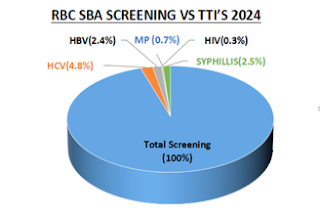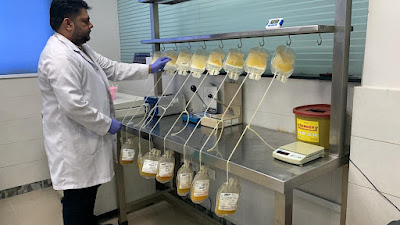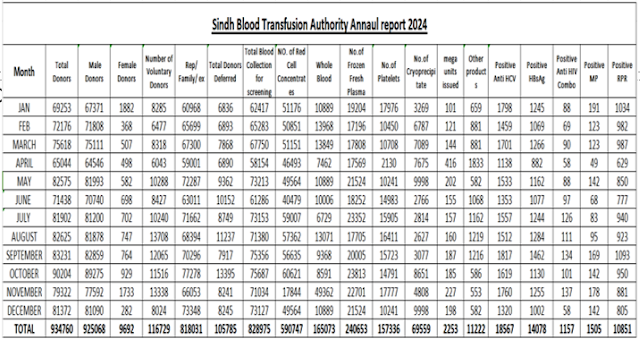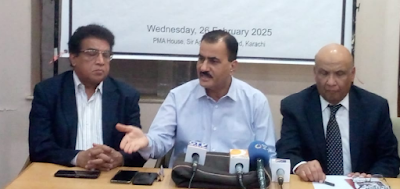Prevalence of TTIs in donated blood termed an issue of concern
 Transfusion transmissible infections rate among blood samples increased to 5.2pc in 2024 from 4.85pc in 2023
Transfusion transmissible infections rate among blood samples increased to 5.2pc in 2024 from 4.85pc in 2023
KARACHI: A summary prepared by the Sindh Blood
Transfusion Authority (SBTA) about the yearly blood collections at various
regional blood centres and blood banks revealed that 5.2% samples of the total
934,760 blood donations –either made voluntarily or availed on the family and
exchange basis— in 2024 tested positive for at least one of the transfusion
transmissible infections (TTIs), a situation that certainly needs to draw
concern from experts and public healthcare authorities in the province.
Despite advancement made in the context of blood
donation safety during the last over a decade in the province, as claimed by
health authorities, TTIs prevailed among blood donors, with the rates:
hepatitis C virus (1.9%), syphilis (1.6%), hepatitis B virus (1.5%), HIV
(0.1%), and malaria (0.1%) in 2024.
Presence of such levels of TTIs among donors needs to be addressed through enhanced screening methods, including sophisticated and foolproof laboratory equipment and gadgets, donor questionnaires and interviews to detect transmissible infections timely, as the population across the province is already overburdened with the diseases in question, health experts opined, fearing laxities and compromises in this regard may lead to skipping of some donors still carrying infections that can be transmitted through blood transfusions.
A comparative study of SBTA data, collected from
regional blood centres (RBCs) and affiliated blood banks, suggested there were
an increase of about 3% in the total donors in 2024, with 116,729 (12.5% of the
total) voluntary blood donors and 818,031 (87.5%) family/exchange donors,
against 102,647 (12.7%) voluntary donors and 806,284 (87.3%) family/exchange
donors in 2023.
However, blood bags yielded collectively by the
RBCs—considered playing a crucial role in ensuring a safe and efficient supply
of blood for diverse medical needs—at Jamshoro, Karachi, Shaheed Benazirabad
and Sukkur came as 186,360 in 2024, against 217,541 in 2023.
The responsibilities of the Sindh government-sponsored RBCs typically include blood collection, screening and testing, storage inventory management, co-ordination, awareness and education.
Infection hotspots across Sindh’s RBCs:- Sukkur RBC reported the
highest levels of infections:
- HCV: 6%
- Syphilis: 2.7%
- HBV: 3%
- Shaheed Benazirabad RBC
recorded the highest HIV rate at 0.3%
The overall TTIs rate among blood samples increased in
2024 to 5.2% from 4.85% in 2023 when the rate of hepatitis C virus remained as
2% of the total donations, with HBV (1.5%), syphilis (1.2%), HIV (0.15%), and
malaria (0.1%).
All the RBCs detected 13,800 TTIs, including 282
malaria, 360 HIV, 3,518 syphilis, 3,655 hep B and 5,985 hep C in 2024, against
a total of 18,414 TTIs, including 459 malaria, 501 HIV, 4,493 syphilis, 4,844
hep B and 8,117 hep C in 2023.
According to researchers, the total number of blood donations in the blood banks across the province showed a progressive increase from 22,822 donors in 2018 to 937,039 donors in 2022.
Infection rates among blood donors in Sindh:- Hepatitis C Virus (HCV):
1.9%
- Syphilis: 1.6%
- Hepatitis B Virus (HBV):
1.5%
- HIV: 0.1%
- Malaria: 0.1%
Referencing to the statistics, experts highlighted the presence of TTIs in blood donors as an issue of concern. They alerted that some infections may not be detectable during the initial stage, allowing infected donors to pass through the screening process. “Screening tests are not 100% accurate, and some cases might be missed, as the current screening process might not be equipped to detect new or emerging infections, while some donors might not disclose their infection status or risk factors.”
Dr Uzma Atta, Director of DUHS blood bank at Ojha campus, said that the TTIs trends in blood screening and overall prevalence of blood transmissible and sexually transmitted diseases are thought provoking, emphasising that blood collection centres and healthcare organisations need to implement more advanced and sensitive testing techniques to detect TTIs.
According to her, majority of the infections are screened positive among donations coming from exchange donors, who may be hiding their diseases in view of the family or friends’ obligations and emergencies the patients are faced with. It is likely that the blood collection centres may not be well equipped or up to the mark, she said, adding the significance of verbal screening and taking donors’ history should not be undermined.
“We can’t deny that load of diseases is significantly high in the population; sometime they are not noticed timely due to lack of diseases surveillance and control system,” Dr Atta said. “A viable but costly solution can be that our RBCs are equipped with more sophisticated analysers /equipment, and all blood samples are presented to it at a central place/laboratory for a foolproof screening on an affordable charge and reporting in a real time.”
Apart from the collections at RBCs, SBTA-monitored blood banks and blood diseases treatment settings across Sindh drew 748,400 donors, including 32,358 (4.32%) carrying TTIs.
According to the official data, the overall percentage
of women blood donors was reported as 1%, including 1,244 from RBC Jamshoro,
followed by RBC Shaheed Benazirabad (754), RBC Sukkur (421) and Karachi (421).
The Karachi RBC got the maximum voluntary donors i.e.
7,250, followed by RBC Sukkur (5,874), Benazirabad (5,016) and RBC Jamshoro
(3,029). Benazirabad reported the maximum number of HIV infected blood samples,
i.e. 79 (0.3%), followed by Karachi and Sukkur RBCs with 0.2% each, and
Jamshoro RBC (0.1%).
A concentration of 6% (1,760 samples) was recorded for HCV at Sukkur RBC, which also shared maximum syphilis infection (2.7%, i.e. 810 samples) and HBV (3%, i.e. 900 samples).
SBTA Secretary Dr Dure Naz Jamal said that apart from
186,360 donations at RBCs, rest of donations came from the public and private
sector registered blood banks.
Each of the Sukkur and Shaheed Benazirabad RBCs got
around 20% of the total donations from the voluntary donors, a good trend,
which can be attributed to community engagement and blood donation campaigns;
effective awareness programmes involving colleges and universities; and blood donation
awareness programmes, she elaborated, observing that blood donation awareness
programmes play a vital role towards increased donations in every society.
Responding to a question, Dr Naz said donors who are
screened positive for TTIs are contacted and counselled duly and are referred
by the dedicated doctors/officials of the blood bank concerned to the lateral
programmes, like the Sindh CDC-HIV, CDC-Hepatitis for further management.
Moreover, SBTA also shares reactive donors’ data with the said programmes on a regular basis for reducing the burden of these diseases in Sindh, she concluded.
-- News report: Social Track
-- Photos: DUHS
-- Graphics and data: SBTA










A very well knitted news story that efficiently emphasizes urgency to set right our priorities... Blood borne infections, a major public health issue may to an extent be curtailed in our province but loopholes continue to haunt us thus demanding both private and government facilities to plug the deficiencies ...
ReplyDeleteIs there a will to do so?
P.S. Lack of resources or/and dearth of funding must no more be the excuse.
Rightly said: a life threatening public health issue.
Delete